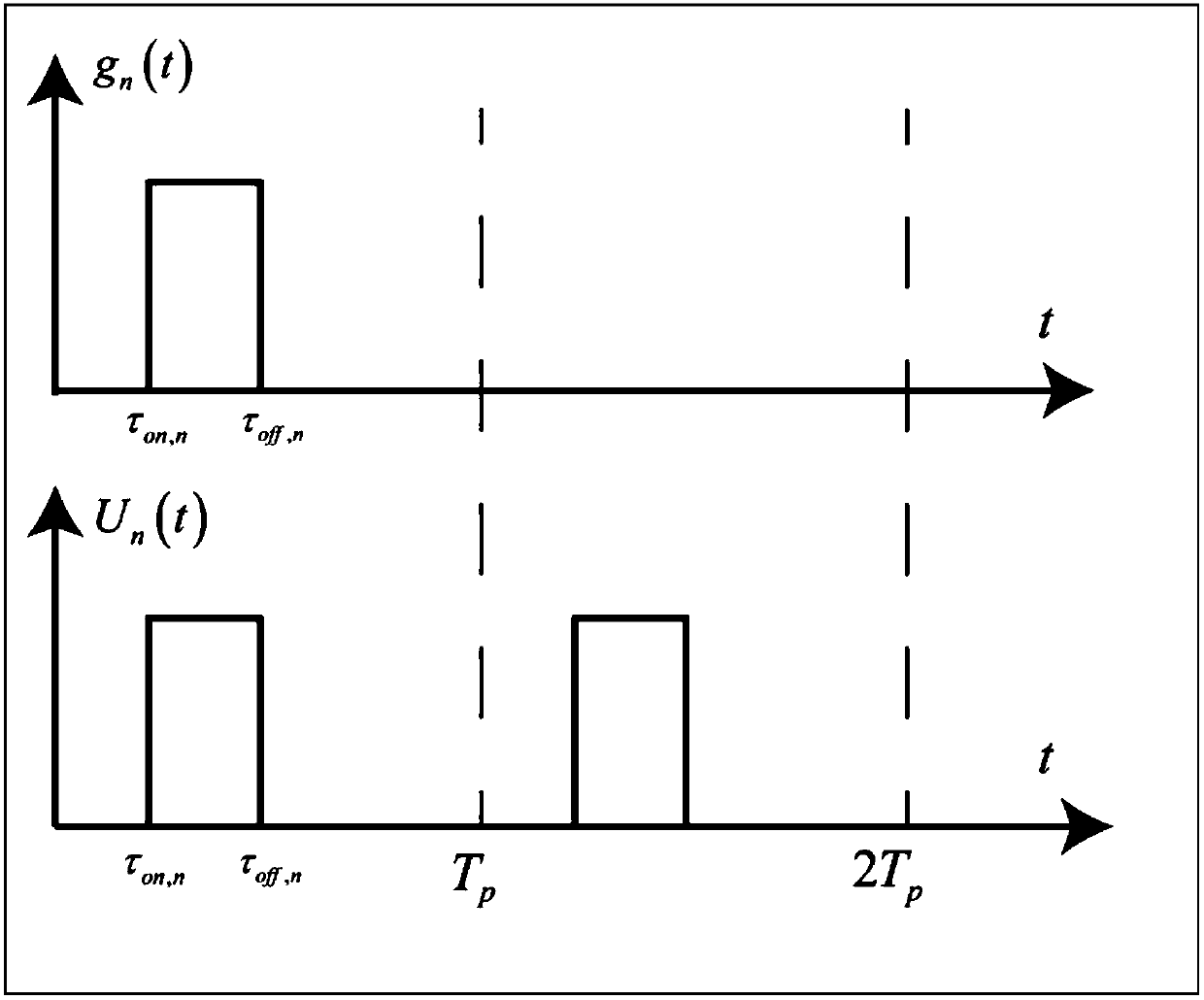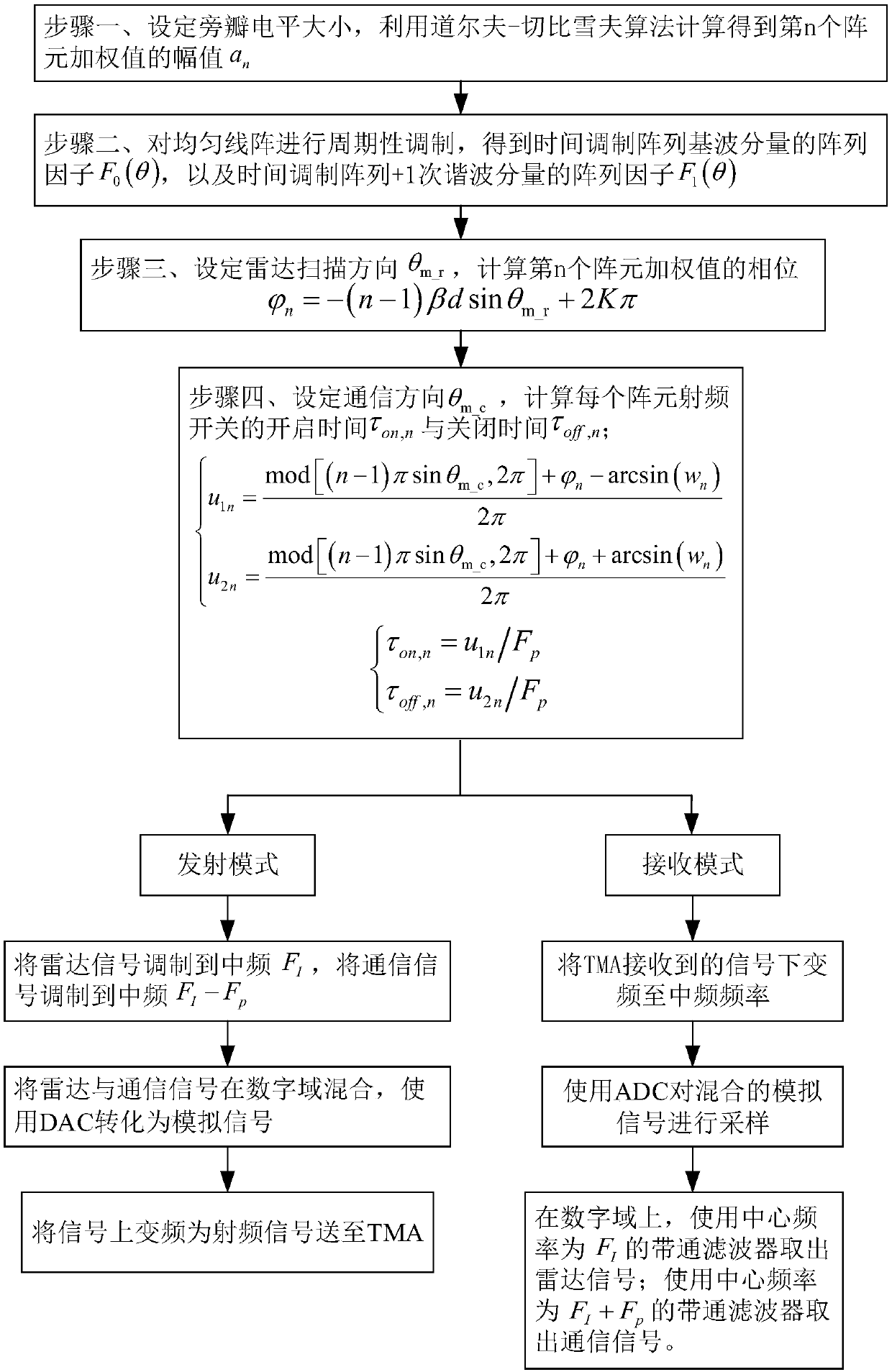Time modulation array based communication and radar integrated design method
A technology of time modulation and design method, applied in radio wave measurement systems, instruments, etc., can solve the problems of unreliability, high complexity, low efficiency, etc., and achieve the effect of improved work efficiency, low complexity, and flexible work
- Summary
- Abstract
- Description
- Claims
- Application Information
AI Technical Summary
Problems solved by technology
Method used
Image
Examples
specific Embodiment approach 1
[0027] Specific embodiment one: a communication radar integrated design method based on time modulation array comprises the following steps:
[0028] Step 1: According to the expression of the array factor of the uniform linear array, use the Dolph-Chebyshev (Dolph-Chebyshev) algorithm to calculate the amplitude a of the weighted value of the nth array element n ;
[0029] Step 2: Periodically modulate the uniform linear array to obtain the array factor F of the fundamental wave component of the time-modulated array 0 (θ), and the array factor F of the time modulated array + 1st harmonic component 1 (θ);
[0030] Step 3: Set the radar scanning direction θ m_r , to calculate the phase of the weighted value of the nth array element
[0031] Step 4: Set the communication direction θ m_c , calculate the turn-on time τ of the RF switch of each array element (a total of N array elements) on,n with closing time τ off,n ;
[0032] Step 5: In the transmitting mode, the radar ...
specific Embodiment approach 2
[0034] Specific embodiment 2: The difference between this embodiment and specific embodiment 1 is: the expression of the array factor according to the uniform linear array is calculated by using the Dolph-Chebyshev (Dolph-Chebyshev) algorithm to obtain the nth array The magnitude of the meta-weighted value a n The specific process is:
[0035] Consider an N-element uniform linear array with an element spacing of d, such as figure 1 shown;
[0036] The array factor F(θ) of the uniform linear array is expressed as:
[0037]
[0038] in, is the weighted value of the nth array element, wavenumber β=2π / λ, λ is the wavelength, θ is the incident azimuth angle of the incident wave, and ψ is the incident zenith angle of the incident wave;
[0039]Set the size of the side lobe level, and use the Dolf-Chebyshev algorithm to calculate the amplitude a of the weighted value of the nth array element n .
[0040] Other steps and parameters are the same as those in Embodiment 1.
specific Embodiment approach 3
[0041] Specific embodiment three: the difference between this embodiment and specific embodiment one or two is: the array factor F of the time-modulated array fundamental wave component is obtained 0 (θ), and the array factor F of the time modulated array + 1st harmonic component 1 The specific process of (θ) is:
[0042] The nth array element is determined by the periodic function U n (t) modulation, expressed as:
[0043]
[0044] Where t is time, T p is the modulation period, m is the period parameter, g n (t) is the gate function, written as:
[0045]
[0046] Periodic function U n (t) AND gate function g n (t) if figure 2 shown.
[0047] Periodic function U n (t) is expanded by Fourier series as:
[0048]
[0049] where F p =1 / T p is the modulation frequency, α nk is the kth order harmonic coefficient, calculated by the following formula:
[0050]
[0051] In time-modulated arrays, equation (1) can be rewritten as:
[0052]
[0053] The arra...
PUM
 Login to View More
Login to View More Abstract
Description
Claims
Application Information
 Login to View More
Login to View More - R&D
- Intellectual Property
- Life Sciences
- Materials
- Tech Scout
- Unparalleled Data Quality
- Higher Quality Content
- 60% Fewer Hallucinations
Browse by: Latest US Patents, China's latest patents, Technical Efficacy Thesaurus, Application Domain, Technology Topic, Popular Technical Reports.
© 2025 PatSnap. All rights reserved.Legal|Privacy policy|Modern Slavery Act Transparency Statement|Sitemap|About US| Contact US: help@patsnap.com



